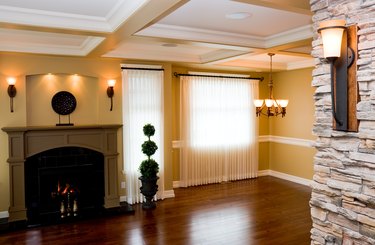Is your dining room missing that special feature that makes it stand out? A chair rail is a simple addition to a room to upgrade the look. Deciding on the height is one of the biggest decisions as part of the installation.

What Is a Chair Rail?
Historically, the chair rail went on walls to keep them from getting damaged from chair backs. These days, this piece of molding is typically decorative in nature. Some people like the look of molding on the wall to break up a block of color. Others use it to separate two different colors, or they might do two different applications on the wall, such as wallpaper on one and paint on the other or wainscoting below the chair rail.
Video of the Day
Video of the Day
Types of Chair Rails
You have a wide selection of materials and styles when it comes to chair rail molding. If you're planning to paint the molding, you can go with an inexpensive paint-grade pine. If you prefer a natural wood look, you can spend as much as you want on hardwood chair rails.
Chair rails come in various thicknesses, heights and profiles. This lets you choose an option that is as simple or ornate as you want. Consider the other trim pieces in the room and the overall style of the space when choosing a chair rail style to make sure it fits. It's a good idea to choose a chair rail that's similar in thickness to window and door trim since the pieces will rest next to one another.
Recommended Chair Rail Height
The general rule of thumb is to install a chair rail approximately one-third of the way up the wall from the floor. To get that approximate chair rail height, measure the ceiling height in inches and divide that number by three. For a standard 8-foot ceiling, that number is 32 inches, while a 10-foot ceiling comes out to 40 inches.
You have leeway in the exact height you use, as the one-third number is just a recommendation to give you a general idea of where the piece should go. The traditional school of thought suggests sticking to a height between 30 and 42 inches from the floor, but some design experts suggest that lower is better to give the room the look of higher ceilings. Use the recommended range as a starting point but consider other options to get your favorite look.
Reasons to Adjust the Height
The overall look you're trying to achieve can influence the chair rail height. Since the molding visually divides the room horizontally, it impacts the proportions of the room and can affect how tall the ceiling looks.
If you install the chair rail higher on the wall, it may make the ceiling feel like it's actually lower. In a room with high ceilings, giving the impression of lowering them can make the space feel more intimate. A room with a low- or standard-height ceiling may feel more closed in with a high chair rail. Consider how you want the room to feel when choosing a height.
Existing features may also impact the decision. For example, if the room already has wallpaper on the lower half with a wallpaper border currently defining the edge, it's easiest to install the chair rail where the wallpaper currently stops. Window trim, fireplaces and existing wall molding can also impact the height. Consider how different chair rail heights look next to those features.
Testing the Chair Rail Height
After you take your measurements and calculate the suggested height of the chair rail, hold a piece of it up to the wall at that height to see how it looks. If you're installing a chair rail and wainscoting together, hold a piece of both up to the wall to test out different height options. Stand back and look at the height from different angles and from outside the room to see what looks the best to you.
There is no right or wrong height, so it's perfectly fine to adjust the height to what looks good to you. Start with the recommended height, work with existing features and play with the height to find a look that you like.